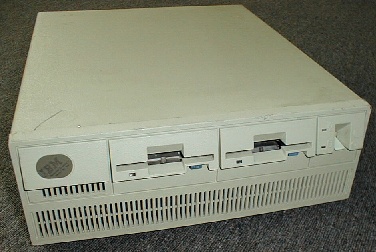
Click here or click onto the photo for a full size version of this picture.
The -Axx variants represented the high-end Model 70's made by IBM. Not only was their processor clocked faster (25 MHz opposed to 16 or 20 MHz), it also had an additional cache memory of 64 Kbytes. It was due to the cache that the performance of an -Axx was almost double as high compared to the 20 MHz variant of the Model 70.
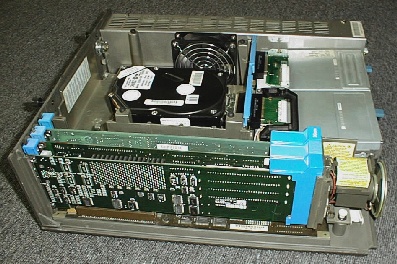
Click here or click onto the photo for
a full size version of this picture.
The mechanical construction is not different from other 70's; the differences manifest themselves only in the different planar, which becomes visible after removing all drives, cards, and the upper plastic frame:
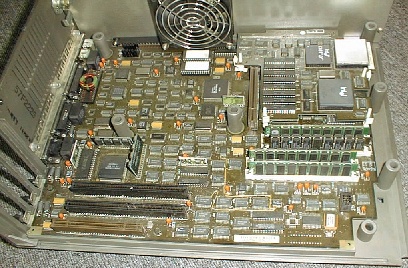
Click here or click onto the photo for
a full size version of this picture.
First of all, the planar is larger; once again the 70's full case space is exploited. I can't say exactly why this board is so much larger that the 16 or 20 MHz variant; it seems that the integration is significantly lower - a large part of the board is covered with bus drivers and other MSI/SSI TTL chips. Maybe parts of IBM's ASICs did not work at 25 MHz? A nice extension is that there is space for one more memory SIMM, raising the maximum on-board memory to 8 Mbytes.
The eyecatcher however is the CPU module that carries processor, FPU, and cache:
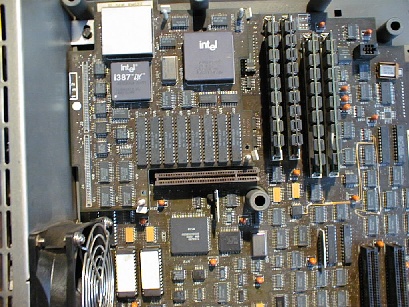
Click here or click onto the photo for
a full size version of this picture.
The module uses the Intel 82385 as cache controller. This was Intel's original offering and was well tailored to cooperate with the i386 without additional glue logic (if you don't count the bus drivers...). Though originally only designed to control a maximum of 32 Kbytes, Intel published a trick to use it with 64K; most vendors, including IBM and Intel itself, exploited this trick. The 82385 was a very advanced cache controller for its time since it already allowed a two-way-set-associative configuration of the cache. However, its ceramic case made it very expensive and most clone PCs quickly switched to cache controllers integrated into the chipset.
The i386 CPU is again a variant manufactured by IBM itself, packaged into the typical IBM aluminum case.
The CPU module's design was 'clean' enough that shortly after the first i486 CPUs came out, IBM was able to offer a 'Power Platform Upgrade' - a CPU module with a 25 MHz i486DX CPU replacing the 386.

Click here or click onto the photo for
a full size version of this picture.
Originally, the Models 50 and 70 used floppy drives of full height (1.6 inch). But these came quickly out of fashion and adapters were thought out to put standard 1-inch drives into the same drive bays. The solution was to screw additional adapter PCBs onto the drives that provide the 'standard' 40-pin edge connector. On the other end...
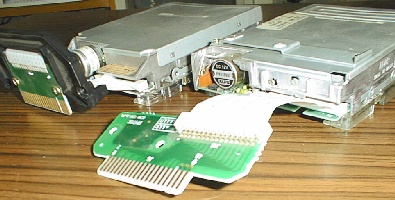
Click here or click onto the photo for
a full size version of this picture.
...a flexible PCB connects to the drive itself. This means however that you cannot use one of the 'later' PS/2 drives with a 34-pin, 2-row connector. The exact pinout of the 'edge to flex' adapter is:
| Edge | Flex | Edge | Flex | Edge | Flex | Edge | Flex |
|---|---|---|---|---|---|---|---|
| 38 | 1 | 38 | 2 | 40 | 3 | 40 | 4 |
| GND | 5 | 2 | 6 | GND | 7 | 4 | 8 |
| GND | 9 | 8 | 10 | GND | 11 | 12 | 12 |
| GND | 13 | 16 | 14 | GND | 15 | 18 | 16 |
| GND | 17 | 20 | 18 | GND | 19 | 22 | 20 |
| GND | 21 | 24 | 22 | GND | 23 | 26 | 24 |
| GND | 25 | 28 | 26 | GND | 27 | 30 | 28 |
| GND | 29 | 32 | 30 | GND | 31 | 34 | 32 |
- Processor:
- IBM 386DX @ 25MHz
- Coprocessor:
- Intel i387DX @ 25 MHz
- Cache:
- 64 Kbytes
- Memory:
- 8 Mbytes (options range from 2M to 8M)
- Bus:
- 3 MCA slots (16/32 bit)
- Interfaces (onboard):
-
- Mouse, Keyboard
- 1x Serial
- 1 x Parallel
- Floppy (1.44M), allows attachment of up to 2 drives
- VGA
- ESDI hard disk (DBA interface)
- Add-on cards:
-
- 3COM 3C523 Ethernet Adapter
- ELSA Gemini/2-158 TIGA Graphics Processor Board
- IBM Dual Serial Adapter
- Operating System(s):
-
- Linux 2.0 (Slackware-based)
- Caldera OpenDOS 7.01
- Useful Links: